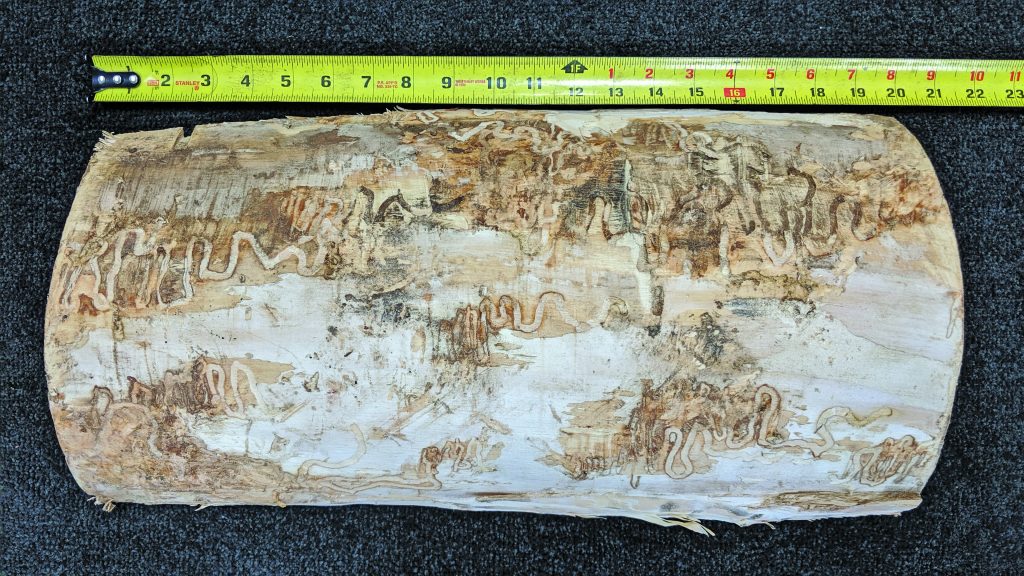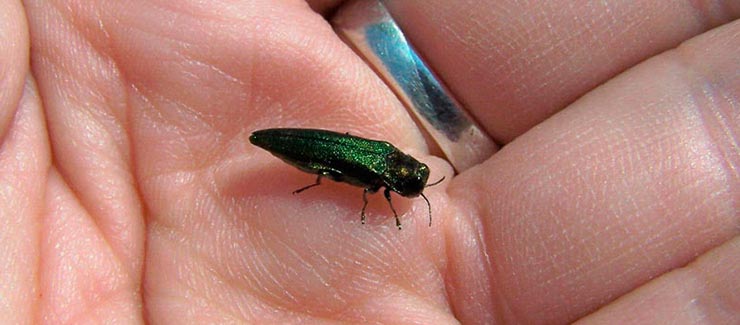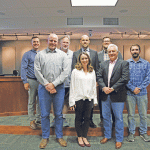Emerald Ash Borer detected near Berthoud


By Amber McIver-Traywick
The Surveyor
National and state experts have confirmed the presence of emerald ash borer (EAB) – an invasive, highly destructive tree pest – only three miles from Berthoud. This detection represents the first ever in Larimer County, and the third confirmation of EAB in Colorado outside of a federal quarantine in less than two months.
An estimated 15% or more of all urban and community trees in Colorado are ash species susceptible to being killed by EAB – and a majority of these trees are on private land. In Berthoud ash trees make up around 22% of trees within the right of way, public parks and cemeteries, but it’s estimated a much higher percentage of these trees are on private property, particularly in old town. EAB attacks and kills both stressed and healthy ash trees, and is so aggressive, trees typically die within two to four years after becoming infested.
According to Josh Embrey, a forester for the Town of Berthoud, the EAB was found approximately three miles southwest of Berthoud on County Road 4 in unincorporated Larimer County at a private residence. It is unknown whether this pest arrived by natural spread or via accidental human transport, such as in firewood or other raw ash material. A tree staff with Larimer County and the City of Loveland recently helped to obtain insect samples gathered at the property, after an arborist brought an ash log containing the insects to the Loveland recycling center. A Colorado State University Extension agent delivered the insects to an EAB expert on campus, who first confirmed it as being the pest; it was then confirmed a second time this week by a national EAB expert in Brighton, Mich.

Embrey said the Town of Berthoud has been proactive in trying to prevent the spread of the pest, “We have had an EAB management program for the past three years. We have the tree advisory committee who have worked hard to do public outreach and a very supportive town council,” however, he continued by saying, “It was not if it came, but just a matter of time before it happened.”
Foresters are now in the process of conducting field inspections of ash trees on other properties in the vicinity to determine the extent of observable EAB infestation.
This detection, like the other most recent Colorado detections in Broomfield and Westminster, occurred outside the existing EAB quarantine. The state quarantine boundaries will not change, however, due to plans for its repeal. The quarantine, which primarily encompasses Boulder County, was established six years ago in an effort to prevent or slow the insect’s spread via the movement of ash nursery stock, firewood and other wood that may contain the pest. The Colorado Department of Agriculture (CDA) and USDA Animal and Plant Health Inspection Service are now preparing to repeal it at the end of the year, with a formal process beginning last month.
The repeal is largely due to the insect’s ability to naturally spread to new areas, without the movement of infested wood being the sole means for population expansion. CDA is also removing the quarantine to allow already-affected communities more options for the disposal of removed trees, and because other means are now in place to help slow the spread of EAB in Colorado. These include the presence of chemically treated trees in affected communities, and bio-controls that prey on EAB now having established populations in Boulder.
Embry suggested Berthoud residents, moving forward, take inventory of what trees they currently have on their property to determine if there are ash trees, “Assess the overall condition of the tree’s health…follow up with a spring evaluation and decide if you want to invest in your tree by treating it or removing and replacing it to contribute to a more diverse urban forest.”
EAB was first confirmed in Colorado in 2013, in the City of Boulder. Since then, the pest has been confirmed in several other municipalities in Boulder County within the quarantine, as well as in Broomfield in late August, and Westminster in September. Experts have now detected EAB in four Colorado counties – all along the northern Front Range.
General public information about EAB is available at csfs.colostate.edu/emerald-ash-borer. Larimer County residents with questions specific to EAB management on their property can also contact their local municipal forester; those outside a municipality with a forestry department can contact the county, CSU Extension or the Colorado State Forest Service:
- August, 13 2015

Polis discusses Iran, Planned Parenth...
By John Gardner The Surveyor U.S. Representative Jared Polis, D-Colo., speaks...
- March, 09 2023

Anna Johnson Hanna taught in Berthoud...
By Mark French The Surveyor Author’s note: Since 1987 the United States has formally...
- August, 04 2014

Meeting the needs of children
By Bob McDonnell The Surveyor Volunteers from Britton Hill Church of...
- July, 15 2016

County Commissioners approve rural su...
By Rudy Hemmann The Surveyor At a land use meeting held Monday evening the Larimer...
- November, 09 2018

Berthoud sales tax increase, Thompson...
By Dan Karpiel The Surveyor Tuesday’s election results demonstrated voters in Berthoud, by a very...
- March, 11 2022

News Bites – March 10, 2022
*Total COVID-19 Cases: 76,661 (+1,069) Total Cases in Berthoud: 3,424 (+48) Deaths in Larimer County:...

Unified basketball comes to Turner Middle School
Community News

Mike Grace says goodbye as Brett Wing joins town board
Community News
POLICEBLOTTER
Community News
Northern Water sets C-BT quota at 70% for 2024
Community News

Emotions run high during Revere Property hearing
Community News
Snowpack at 119% above normal
Community News

Karspeck to serve third term as Berthoud mayor
Community News
COMMUNITY CALENDAR:
Community Calendar – add an event
Homestead Fine Art Gallery First Fridays OPEN HOUSE
03 May 4:00 PM - 7:00 PM
Homestead Fine Art Gallery First Fridays OPEN HOUSE
07 Jun 4:00 PM - 7:00 PM
Homestead Fine Art Gallery First Fridays OPEN HOUSE
05 Jul 4:00 PM - 7:00 PM
Homestead Fine Art Gallery First Fridays OPEN HOUSE
02 Aug 4:00 PM - 7:00 PM
Homestead Fine Art Gallery First Fridays OPEN HOUSE
06 Sep 4:00 PM - 7:00 PM
Homestead Fine Art Gallery First Fridays OPEN HOUSE
04 Oct 4:00 PM - 7:00 PM

